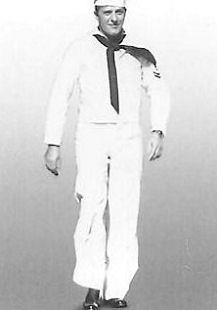

U.S. NAVY WWII
by George Hurley
Albert Berger is a native of Baltimore, Maryland. While working at the Bethlehem Fairfield Shipyard as a welder, he thought he should join the military. At that time the company was building Liberty ships and LST’s, landing craft designed to carry men and equipment. Albert was told he could count on being employed for at least ten years. However, because all of his friends and his brother had volunteered, he decided to join the Navy, hopefully to become a member of the Seabees, the Navy’s construction branch. Albert spoke with a recruiter who told him he would not be accepted because the job he held was vital to the war effort. Having had a disagreement with Union officials, who in retribution for Albert’s action, forced him in to jobs which placed him in tight quarters where he was exposed to asbestos, Albert left his employment in November of 1942. When he informed the recruiter of his decision to leave his job, the recruiter processed his application, and Albert was called to duty in March of 1943.
Albert began his Seabee training in Williamsburg, Virginia. The Marine Corp conducted ninety percent of the training. Navy non-commissioned officers who taught seamanship completed the rest.
Six weeks later Albert was shipped to Davisville, Rhode Island, for advanced training, and then on to Shoemaker, California, for further training.
Upon completion of training, Albert left San Diego bound for Barbers Point, Hawaii, on the island of Oahu. He remembers spending Thanksgiving Day of 1943 aboard ship. Seas were rough, and many men were suffering from seasickness. “Standing at a counter eating your dinner while someone else standing next to you is throwing up—hard to imagine it did happen. Those are experiences.” Assigned to the 109th Naval Construction Battalion, his first assignment was to build Quonset huts for his own battalion and two others that were supposed to land within the next week. In eight days, during which Albert’s battalion stayed on board ship, the barracks were completed. These huts housed eighteen hundred men, sixty or sixty-five men in each. Albert was not assigned to actual construction but rather to the Personnel Office. Although he preferred fieldwork, he did his job because “that is where they (the Navy) assigned me.”
The battalion left Hawaii, headed for Kwajalein Atoll in the Marshall Islands. They arrived two days after the Marines had landed. Prior to the Marines coming ashore, the island had been shelled for three or four days by ships off shore. The bombardment destroyed every tree with in sight, and there appeared to be nothing living on the island. The battalion was warned, however, to be careful because there were still some Japanese on the island. “Some would come out at night. Our patrols killed two or three.” On the fifth night Japanese planes raided the island, dropping bombs. One bomb, called the “daisy cutter”, was designed to explode before it hit the ground, sending shrapnel and fire everywhere. The battalion suffered some loses. One man “went off his rocker” when the first bomb hit. He started running, screaming, “The Japs are coming,” and ran in to the ocean where he drowned. The battalion spent four or five months in the Marshall Islands rebuilding the airstrip and constructing quarters for the men who would be stationed there.
Returning to Hawaii for rest and recuperation, the battalion was quartered at Mauna Loa Ridge, which overlooked Hickman Field. They also had the chance to stay at the Royal Hawaiian Hotel for a week. While at Mauna Loa, some of the battalion became ill from drinking bad alcohol; two went blind.
The battalion was ordered to Guam in the Mariana Islands. They remained there for quite a while doing construction work. Albert says, “The next thing I knew it was August of 1945. I woke up and the radio was saying, ‘The war is over.’”
The 109th Naval Construction Battalion stayed intact to finish work on Guam. Since Albert was a “pencil pusher” who had thirty months of overseas duty and the correct number of points, he was the first one to leave the battalion. He got home on November 9th of 1945. He traveled by train from the West Coast to Bainbridge for discharge. He spent that winter in Florida and in March 1946 became a permanent resident of Ocean City Later he would learn that Dr. Frank Townsend must have checked him out in Bainbridge. “He became my doctor for over forty years, and we were good friends. We used to meet and walk the boardwalk together twice a week”
When asked about his final thoughts regarding the war, Albert admitted to having mixed emotions. “I understood that the atomic bomb demolished an entire city and wiped out ninety percent of the population. But in thinking about it, well, we were getting ready to invade Japan. Probably we would have lost more people and Japan would have lost more people than the bomb destroyed. So, in hindsight, I think President Truman did what he did because he was all about saving lives. I was glad that I did what I did, and I know we lost numbers of men in the Pacific, but I think we lost a lot more in the European phase of the war.”
Mr. Albert (Al) Berger will be ninety-three years old in August 2009. During his long time residency in Ocean City, Maryland, he has been involved with the Ocean City Volunteer Fire Department, the Ocean City Lions Club, and a very dedicated member of his synagogue. His business background has included retail stores and real estate and development. His most recent achievement involved assisting his sister Martha in developing the Martha’s Landing complex in West Ocean City. George M. Hurley, a long-time friend, conducted this interview.
Mr. Hurley’s interview with Albert Berger was further abridged by Allan Kastner in keeping with the format approved by the Worcester County Veterans Memorial Board of Directors.
